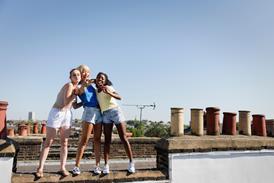- Home
- About
- Topics
- Parenting
- Stories
- Growing faith
 Christian devotions at home for children with additional needs are hard but worth working at
Christian devotions at home for children with additional needs are hard but worth working at Parents are the key to bridging the gap between church and school
Parents are the key to bridging the gap between church and school A tool to help your child ‘take captive every thought’ and walk in freedom with Christ
A tool to help your child ‘take captive every thought’ and walk in freedom with Christ ‘What do you do?’ A Christian mum finds the question triggered more than she expected
‘What do you do?’ A Christian mum finds the question triggered more than she expected
- NexGenPro
- Donate
Backpacking to Easter
By Alex Taylor is the Resources Editor at YCW Magazine

Children travel around Europe exploring the events of Jesus’ life from Palm Sunday to Easter Sunday in new holiday club programme Backpackers. We asked its author, Alex Taylor, to use the same themes to help us investigate the Easter story for ourselves. Use these reflections as you journey with Jesus from Palm Sunday to his crucifixion and resurrection
This article is for subscribers only - SIGN IN here
If you want to read more, subscribe now for instant access to 1000s of resources, advice, ideas and support for anyone involved in family, youth and children’s ministry.
PLUS receive a weekly newsletter to keep you up to date with what’s new, what’s seasonal and what’s in the news!
If you are already a NexGenPro subscriber, SIGN IN
Related articles
-
 Article
ArticleHow to successfully navigate the Christmas chaos with those with additional needs
2023-12-11T11:46:00Z By Mark Arnold
It’s Christmas!! Those two words seem to divide the nation even more than Brexit has, with people falling into one of two ‘camps’… Either you started wearing your Christmas jumper in October, had your decorations up in November, and have already watched ‘Elf’ 12 times this season, or you feel ...
-
 Issues
IssuesHelp, I have a child with ADHD!
2023-09-20T12:51:00Z
Sam Donoghue and Catherine Truelove give their perspective on two tricky questions asked by youthworkers
-
 Article
ArticleSeptember resources
2023-09-06T13:46:00Z
With the new school term under way we have oddles of tasty resources for you on the NexGenPro website. You can simply browse to the topics you fancy and download and use curriculum for your group. Some choose to use the three year curriculum approach that NexGenPro ...
More from NexGenPro
-
 Article
ArticleBeing a steward of resources for Children’s and Youth Ministry
Steve Henwood takes a look in the games cupboard and reflects on how we need to think about the ‘stuff’ of youth ministry and how we can get more
-
 Article
ArticleGet yourselves a silent disco headsets – the multi-faceted ministry tool
2024-01-11T11:28:00Z
Steve Henwood is convinced that your youth ministry could have a new dimension if you can raise the funds for this versatile gadget
-
 Article
ArticleMore tools to help the Bible ‘stick’ in your life and those you serve
2024-01-11T09:42:00Z By Tim Alford
Tim Alford continues his exhortatation for us to make the Bible a vital part of your life
- Topics A-Z
- Writers A-Z
- © 2025 NexGen
Site powered by Webvision Cloud





























